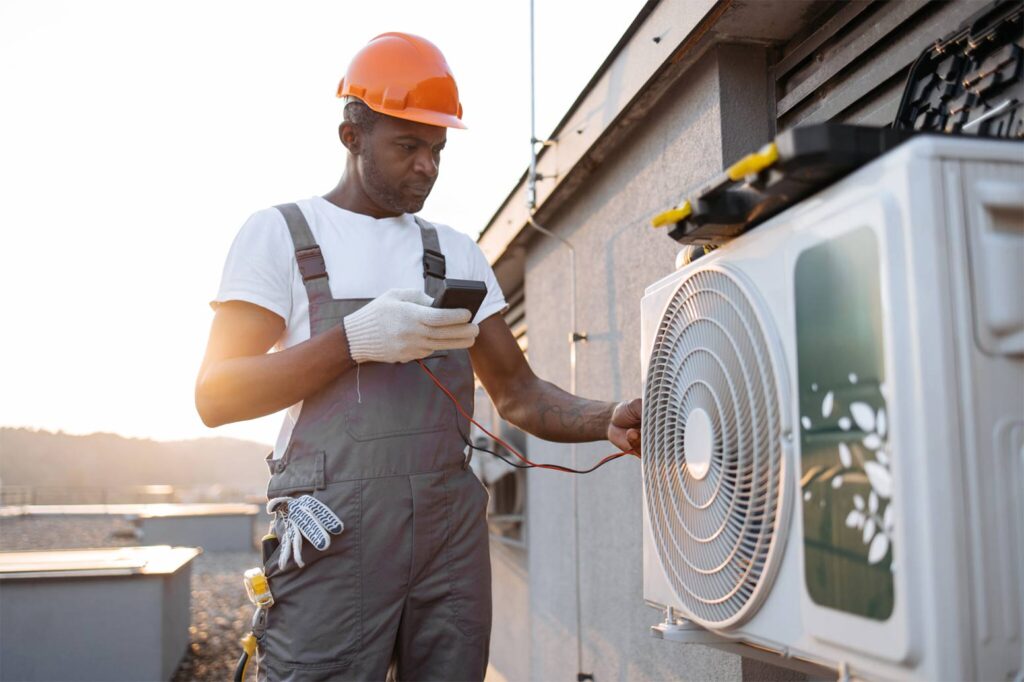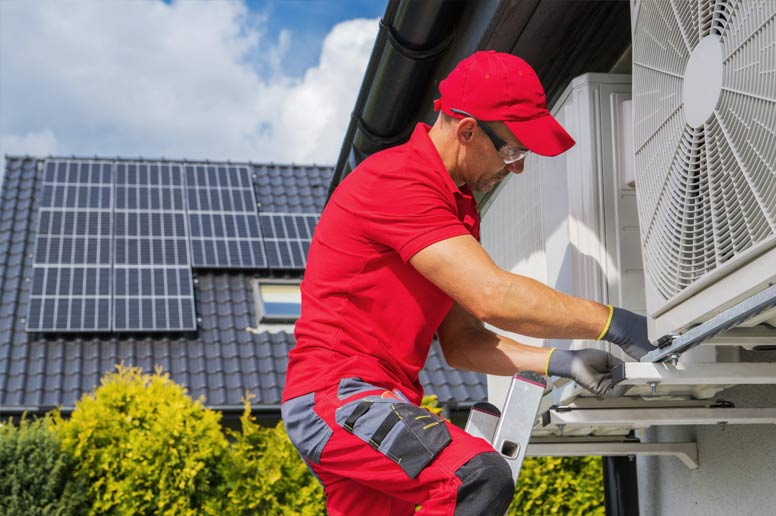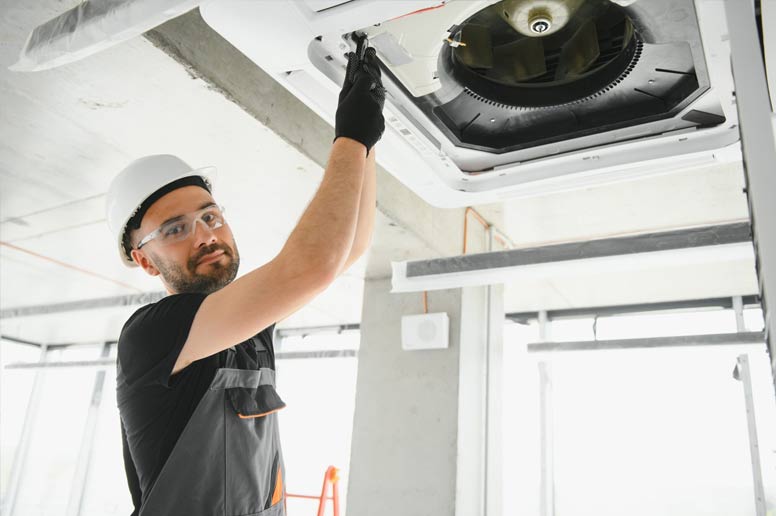HVAC Pricing Guide: How to Charge Confidently

Table of Contents
- Why Do I Need to Get My HVAC Pricing Guide Right?
- How To Calculate HVAC Costs?
- Comprehensive Breakdown of Average HVAC Costs
- Factors Influencing HVAC Costs
- Choosing the Right HVAC Pricing Strategy for Your Jobs
- How to Calculate HVAC Pricing
- Leveraging HVAC Pricing Software
- Trends Impacting HVAC Pricing in 2024
- Ready To Price Like a Pro?
- HVAC Business Insurance FAQs
In this article we are breaking down an HVAC Pricing Guide, to help you understand how to set up a competitive pricing and charge your clients comfortably for your HVAC services.
For HVAC businesses (heating, ventilation and air conditioning), pricing jobs can feel like walking a tightrope—you need to stay competitive without undercutting your profits.
Whether you’re just starting or rethinking your pricing strategy, this guide will help you set rates that strike the perfect balance between profitability and customer satisfaction.
From understanding key cost components to leveraging modern pricing tools, we’ll break it all down so you can confidently price your HVAC services in 2024 onwards.
Why Do I Need to Get My HVAC Pricing Guide Right?
Pricing isn’t just about deciding how much you’ll charge customers, it’s about defining your business’s success. Set your prices too high, and you risk losing out to competitors. Set them too low, and you may struggle to cover costs, let alone make a profit.
Why getting your HVAC pricing strategy right matters:
- Profitability: Pricing correctly ensures you cover labour, materials, and overhead costs while achieving healthy profit margins.
- Customer Trust: Transparent, fair pricing builds credibility with customers and fosters long-term loyalty.
- Market Competitiveness: Keeping your rates in line with industry standards makes you attractive to customers while differentiating you from “low-cost” competitors that often compromise on quality.
Effective pricing also helps you weather unexpected challenges, such as rising material costs, labour shortages, or seasonal fluctuations. Without a solid pricing framework, these issues can easily eat into your profits or overwhelm your operations.
Want to take the guesswork out of invoicing? Learn how Invoice Fly can help you streamline your pricing and invoicing process.
RELATED ARTICLE: How to Start an HVAC Business? Step-by-Step Guide

How To Calculate HVAC Costs?
To price your HVAC services accurately, you’ll need to account for three core components:
1. Labour Costs
Labour is typically the largest expense for HVAC businesses, so getting this calculation right is critical.
- Technician Wages: According to the U.S. Bureau of Labor Statistics, HVAC technicians earned a median wage of $27.55/hour in 2023.
- Additional Costs: Wages are just the start—taxes, benefits, and insurance can add significantly to your labour costs. For example, a technician earning $25/hour may cost you closer to $35/hour when factoring in these extras.
Example: For an 8-hour job with a labour cost of $35/hour, your total labour expense would be $280.
2. Material Costs
The cost of materials depends on the type of job, the quality of your HVAC equipment, and market conditions.
- Equipment Costs: Installing a heat pump can range from $4,000–$8,000, depending on the system size and efficiency.
- Markup Opportunities: Applying a markup to materials helps cover hidden costs, such as warranty claims or unexpected material price hikes.
- Variable Pricing: Be prepared for fluctuating material costs due to supply chain issues or seasonal demand spikes. Using HVAC pricing software can help you stay on top of these changes.
Pro Tip: Buy in bulk – Stock up on frequently used materials like filters or refrigerants during off-season periods when prices are lower.
3. Overhead Costs
Overhead includes all the expenses that keep your business running, from office rent to marketing and software subscriptions. These costs should be distributed across all your jobs.
- Example Calculation: If your monthly overhead is $4,000 and you complete 20 jobs per month, you’ll need to allocate $200 per job to cover overhead.
Pro Tip: Break down overhead into fixed costs (e.g., rent, utilities) and variable costs (e.g., fuel, additional supplies for large jobs). This helps you track and manage expenses more effectively. Track your expenses with our receipt scanner feature.
RELATED ARTICLE: HVAC Technician Salary Guide in 2025 in the United States

Comprehensive Breakdown of Average HVAC Costs
Repairing your heating or cooling system typically costs between $150 and $2,700, depending on the severity of the issue and the size of the property. For an HVAC service call, expect to pay $75 to $250+, with the exact cost depending on the problem being addressed.
- AC Repair Costs: On average, repairing an air conditioning unit costs $320, while an AC tune-up is approximately $99.
- HVAC Technician Rates: Hourly rates range from $65 to $150+, with additional parts costing anywhere from $40 to over $1,000. Flat labor fees for certain services are typically $50 to $200+, not including materials. Total job costs can range from $100 to over $1,500.
Factors Influencing HVAC Costs
Several factors may affect the cost of HVAC repairs and services:
- System Age: Older systems often require more maintenance and may incur higher costs due to inefficiencies or outdated parts.
- Home Size: Larger homes require larger systems, which increase labor and material costs.
- Location: Regional differences in labor rates can significantly influence the final cost.
- Timing: Weekend or after-hours service calls may carry higher charges than weekday appointments during regular business hours.
- Nature of Repairs: Simple fixes, such as refrigerant refills, cost less than major replacements like compressors or motors.
Average HVAC Installation Costs
- Complete HVAC System Costs: The average cost ranges from $5,000 to $12,000, with higher-end systems reaching $15,000 or more for large homes or advanced systems.
- Air Conditioner Installation: $3,500 to $7,500, depending on the type and size of the unit.
- Furnace Installation: $2,500 to $6,500, with gas furnaces generally costing more than electric models.
- Heat Pump Installation: $4,000 to $8,000, depending on the model and efficiency rating.
- Ductwork Installation: $2,000 to $6,000, depending on the complexity and size of the duct system.
Average HVAC Replacement Costs
- Complete HVAC System Replacement: Costs range from $5,000 to $12,500, with high-end systems for larger homes reaching $15,000+.
- Air Conditioner Replacement: $3,500 to $8,000, depending on the unit’s size, efficiency, and type.
- Furnace Replacement: $2,500 to $7,500. Gas furnaces are generally more expensive than electric models.
- Heat Pump Replacement: $4,000 to $10,000, with costs influenced by the efficiency rating and system size.
- Ductwork Replacement (if needed): $2,000 to $6,000, depending on the scope of work and home layout.
HVAC Tune-Up Costs
Routine HVAC tune-ups, recommended annually for optimal performance, typically cost a few hundred dollars. Regular maintenance helps improve efficiency, reduce electricity bills, and extend system lifespan by preventing costly breakdowns.
AC Repair Costs
The price of AC repairs depends on various factors, including the system type, unit size, brand, and age. Repair costs average $135 to $450 per hour, with more complex repairs—such as motor, evaporator coil, or compressor replacements—reaching $1,000 or more.
Furnace Repair Costs
Furnace repairs average $280 nationally, with costs ranging from $60 to $880 depending on the problem.
- Electric furnace repairs: typically $350 or less.
- Gas furnace repairs: $375 to $1,200, reflecting their complexity and parts requirements.
Common HVAC Problems and Costs
Here’s a list of typical HVAC issues and their associated costs:
- Freon Refill: $250 – $600+
- Thermostat Replacement: $250 – $750+
- Condenser Motor Replacement: $800 – $1,000+
- Compressor Replacement: $1,200 – $3,000+
- Blower Motor Fan Replacement (Gas Furnace): $500 – $1,000+
Choosing the Right HVAC Pricing Strategy for Your Jobs
Your pricing method can make or break your business, so it’s important to choose the right strategy for each type of job.
HVAC Flat-Rate Pricing
Flat-rate pricing assigns a fixed price to a job, regardless of the time or resources it takes.
- Pros: Customers appreciate the predictability of flat-rate pricing, and it allows you to standardize pricing for similar jobs.
- Cons: Unexpected complications can shrink your profit margins if you haven’t factored in enough contingency.
Example: Offering a flat rate of $250 for routine maintenance simplifies the quoting process but requires careful planning to ensure it’s profitable.
Time-and-Materials Pricing
This approach charges customers based on the time spent and the materials used.
- Pros: Ideal for complex or unpredictable projects where costs can vary significantly.
- Cons: Customers may be uneasy about escalating costs during the project, so transparency is key.
- When to Use It: Flat-rate pricing works best for standard jobs like routine maintenance, while time-and-materials pricing is better suited to custom projects or repairs with uncertain scopes.
How to Calculate HVAC Pricing
Follow these steps to arrive at competitive and profitable rates:
- Calculate Total Costs: Add up your labour, material, and overhead costs to establish a baseline for each job.
- Set a Markup: Apply a percentage markup to ensure profitability. For example, a 30% markup on $1,000 costs means you’ll charge $1,300.
- Determine Margins: Your profit margin is the percentage of profit relative to the selling price. Aim for a 15–20% margin to sustain and grow your business.
Pro Tip: Incorporate a contingency fee (5–10%) in your estimates to cover unforeseen expenses.
Leveraging HVAC Pricing Software
Managing HVAC pricing manually can be tedious, time-consuming, and prone to errors. That’s where specialized HVAC pricing software comes in—making the process easier, faster, and more professional.
Benefits of HVAC Pricing Software
- Consistency: Ensure uniform pricing across all jobs and technicians with ease.
- Efficiency: Save valuable time on calculations so you can focus on delivering exceptional service.
- Transparency: Provide clients with clear, itemised quotes that build trust and professionalism.
Why Choose Invoice Fly for HVAC Pricing?
Invoice Fly’s Software is designed for HVAC small businesses and contractors, and it’s is built to help your business thrive. From streamlining pricing calculations to generating professional invoices, it’s designed with HVAC professionals in mind.
Features That Work for You:
- Customisable pricing templates for routine and complex jobs.
- Integrated tools to calculate labour, materials, and overhead effortlessly.
- Automatic invoicing features that sync with your pricing for seamless workflows.
- Reporting tools to track profitability and identify growth opportunities.

Trends Impacting HVAC Pricing in 2024
Stay ahead of the competition by considering these trends:
- Eco-Friendly Systems: Consumers are increasingly demanding energy-efficient and sustainable HVAC solutions. Offering green options can set you apart.
- Labour Shortages: The demand for skilled technicians is driving up wages, so plan your labour costs accordingly.
- Material Inflation: Supply chain disruptions and inflation are pushing material costs higher. Keep an eye on these changes and adjust your pricing strategy as needed.
Ready To Price Like a Pro?
Pricing your HVAC services correctly is about covering costs and building a business that’s both profitable and customer-focused.
By understanding your expenses, choosing the right pricing strategies, and leveraging helpful tools, you can confidently set rates that work for both your bottom line and your customers.
Ready to streamline your operations and focus on growth?
Try Invoice Fly today to manage your invoices, track expenses, and simplify your business processes.
HVAC Business Insurance FAQs
HVAC companies typically aim for a profit margin between 8% and 12%. This can be achieved by managing overhead costs, optimizing pricing for service calls, and ensuring competitive rates for HVAC units and installations.
Yes, workers' compensation insurance is essential to protect HVAC technicians from injuries sustained on the job. It ensures that medical expenses and lost wages are covered, providing peace of mind for business owners.
General liability insurance protects HVAC companies if a technician accidentally damages an air conditioner or other property during a job. A must-have for any professional in the HVAC industry.
Insurance safeguards HVAC businesses during service calls by covering risks like property damage, lost tools, or accidents. This ensures smooth operations and builds trust with clients.
In the HVAC industry, comprehensive insurance protects against various risks, from damaged AC units to lawsuits over installation errors. It ensures business owners can focus on growth without worrying about financial setbacks.
